Right-wing media have repeatedly distorted the Obama administration’s record on border enforcement to claim that the border is not secure and that, in fact, the government has failed “to secure the states against invasion,” as Fox News contributor Michelle Malkin has put it.
On Fox News’ Hannity, Malkin claimed that “this current administration has done everything in its power to sabotage immigration law,” and asked: “Why would you trust them one iota with the job that they will not do – that they refuse to do?” Host Sean Hannity added: “I want that border secure and I think we’ve got to get it done for our national security.”
As the House prepares to debate the issue following the Senate passage of a bipartisan immigration reform bill that includes enhanced border measures, conservative media figures have used border security as a sticking point against which to derail reform.
But here are the facts on border enforcement.
Deportations Are At Historic Highs
The Obama administration has deported a record number of undocumented immigrants, which has angered immigrants rights’ activists who argue that the rise in deportations has impacted families of those deported.
In FY 2012, deportations totaled 409,849 – the highest they’ve ever been.
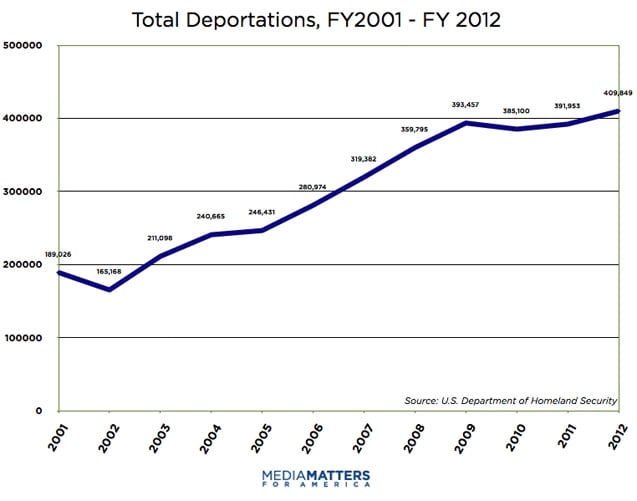
In the past four years, U.S. Immigration and Customs Enforcement has deported a record number of immigrants the government classifies as “priority removals,” which includes those who have been convicted of crimes or are a threat to public safety.
In fact, 55 percent of those deported were classified as “convicted criminals,” an increase of nearly 20 percent from 2009.
Apprehensions Are At An All-Time Low
At its peak, U.S. Border Patrol data show that apprehensions of undocumented immigrants nationwide and along the Southwest border routinely topped 1 million. For example, in FY 2004, the Border Patrol counted nearly 1.2 million apprehensions along the Southwestern border. By FY 2009, that number had declined to 540,865.
In FY 2012, the Border Patrol apprehended 364,768 individuals nationwide, 98 percent of whom were caught on the Southwestern border.
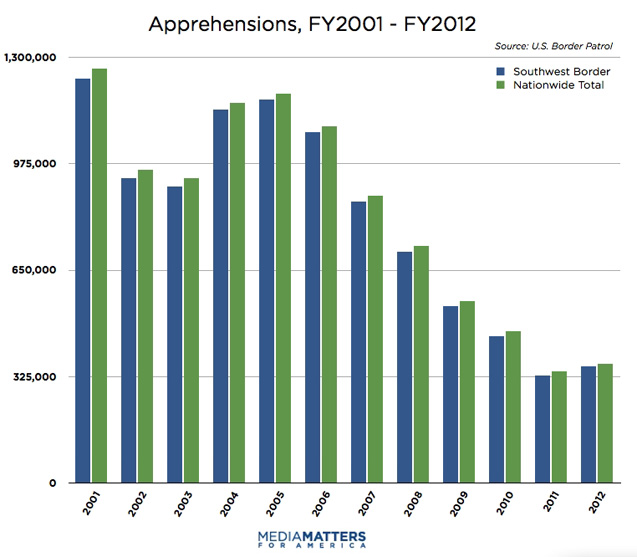
According to the Arizona Daily Star, as of April 2, “192,298 people have been detained this fiscal year, compared with 170,223 during the same period last year, unofficial data shows.” The Star added: “Apprehensions in the Tucson Sector – the busiest section of the border — are down 1 percent so far this year to 64,514. But the Rio Grande Valley in Texas, arrests are up 53 percent to 59,147.” The Star went on to report that “the recent growth in apprehensions is due to more Central Americans attempting to cross.”
There Are Record Numbers of U.S. Border Patrol Agents
Since FY 2001, the U.S. Border Patrol has steadily increased its number of agents from 9,821 agents nationwide — the bulk of whom (93 percent) were stationed on the Southwestern border — to more than double today at 21,395 agents. Eighty-six percent of those agents today are located on the Southwestern border.
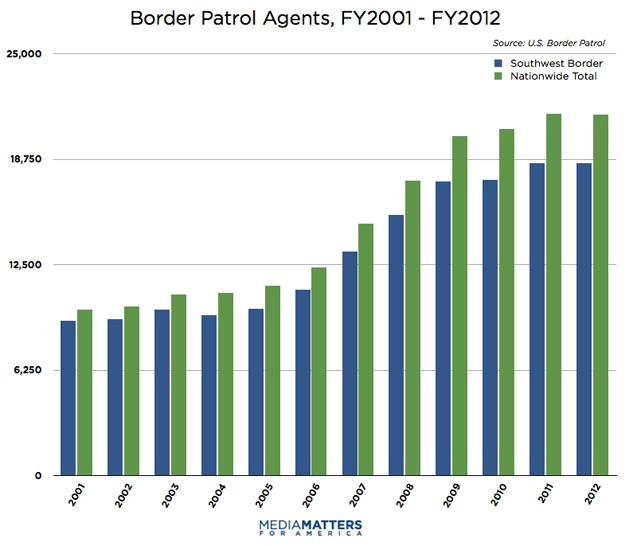
The Border Patrol Tuscon sector in Arizona boasts the most agents at 4,176, which is more than double the number of agents in 2003. More than half of the agents on the Southwestern border are located in the following sectors:
· Tuscon: 4,176 agents
· El Paso: 2,718 agents
· San Diego: 2,623 agents
· Rio Grande Valley: 2,546 agents.
The Rio Grande Valley has added more Border Patrol agents in the last fiscal year than any other sector nationwide.
There Are Record Numbers of ICE Agents
According to U.S. Immigration and Customs Enforcement data provided to the Immigration Policy Center*, there is a record number of ICE agents in the field tasked with enforcement and removal operations.
As of FY 2012, there are about 6,338 agents in the Enforcement and Removal Operations (ERO) division, which is double the number the program had in 2003 at 2,710, according to the organization’s estimates.
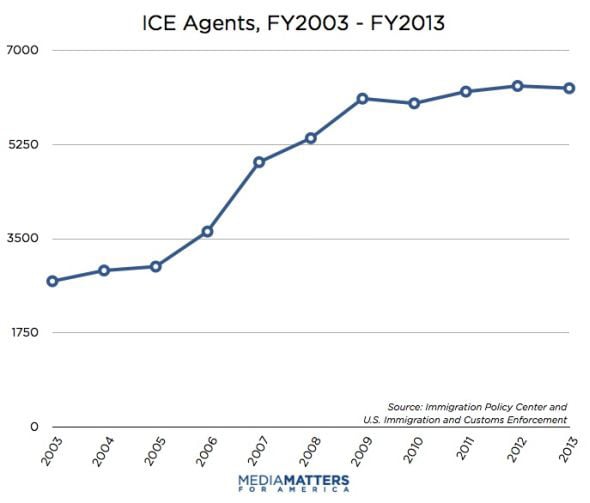
Spending On Border Enforcement Has Doubled
The total budgets for CBP and ICE have doubled in the decade since the inception of the Homeland Security Department in 2002, with CBP’s budget totaling about $11.7 million in FY 2012.
In FY 2012, ICE’s budget stood at about $5.9 million.
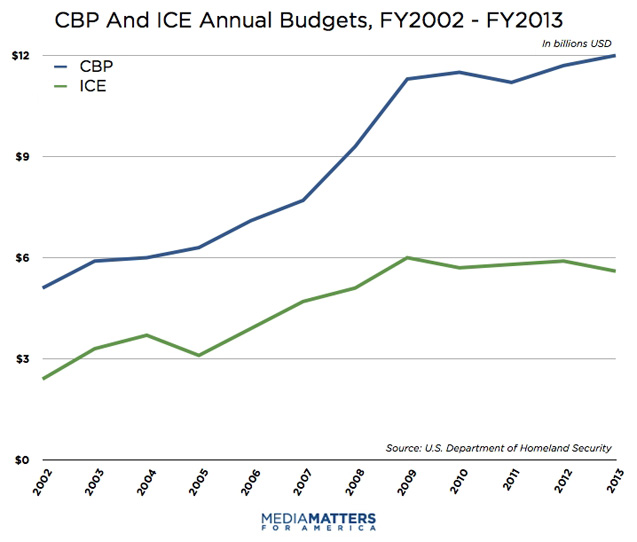
The budgets for CBP and ICE have increased to such a degree that they now comprise 31 percent of DHS’ total spending in FY 2013. CBP’s budget alone has risen from 15 percent of Homeland Security’s total spending in FY 2005 to 21 percent today – the most for any agency under DHS’ purview.
CBP’s budget eclipses that of the U.S. Coast Guard and the Transportation Security Administration, which comprise 17 percent and 13 percent of DHS’ total spending respectively. By contrast, the U.S. Secret Service, the agency tasked with protecting the president and vice president, is a mere 3 percent.

Fence On U.S.-Mexico Border Stretches 650 Miles
The U.S. border with Mexico stretches 1,954 miles from California to Texas, according to the U.S. International Boundary and Water Commission. As the U.S. Government Accountability Office has noted, however, the “length of the land border is 675 miles, while the length of the border along the Colorado River and Rio Grande is 1,279 miles.”
On October 26, 2006, President George W. Bush signed into law the Secure Fence Act, which authorized $1.2 billion for the building of 700 miles of fencing along the Southwestern border. Before 2006, according to GAO, there were about 120 miles of fencing on the U.S.-Mexico border.
That number has grown to 651 miles of fencing, according to U.S. Customs and Border Protection:
As of February 10, 2012, CBP has completed 651 miles of pedestrian and vehicle fencing along the Southwest Border. CBP has constructed a total of 352 miles of primary pedestrian fence and 299 miles of vehicle fence. CBP has approximately one mile left to be completed for the Pedestrian Fence (PF225) project. This will bring the total to 652 miles of fence along the Southwest Border.
As this Washington Post graphic makes clear, the bulk of the fencing on the U.S.-Mexico border is situated on land, with California, Arizona, and New Mexico almost completely fenced off. As the Post further notes, the “Rio Grande creates a natural partition” along the remaining border miles in Texas:
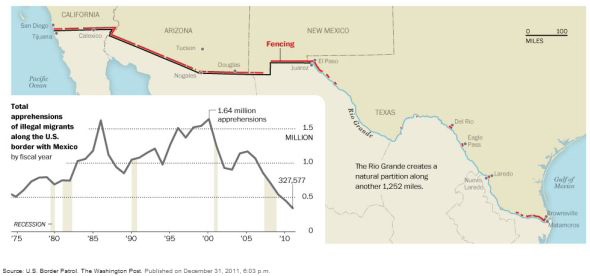
Senate Immigration Reform Bill Militarizes Border In Afghanistan-Style Surge
The comprehensive immigration reform bill that passed the Senate on June 27 includes a drastic increase in border enforcement measures, which has led even conservative think tank the Competitive Enterprise Institute to claim it ushers in “military-style mobilization” on the U.S.-Mexico border. CEI wrote on June 26 that the bill’s border provision “is not simple ‘border security’ — personnel-wise, it’s a mobilization proportional to the one in Afghanistan.”
Discussing the border provisions — which were added in an amendment authored by Sens. Bob Corker (R-TN) and John Hoeven (R-ND) — on CNN on June 25, Sen. John McCain (R-AZ) said the bill would turn the Southwestern border into the “the most militarized border since the fall of the Berlin Wall”:
McCAIN: I think that, first of all, the legislation concerning beefed up border security removes any validity to the argument that border security is not sufficient. I mean, this is not only sufficient, it is well over sufficient. We’ll be the most militarized border since the fall of the Berlin Wall so that’s why I think this amendment was very important.
In addition to fortifying the border in each sector between ports of entry, the amendment provides for the following:
1) Adds Another 17,000 Border Patrol Agents
The bill allocates $30 billion in additional funding for “no fewer than 38,405 trained full-time active duty U.S. Border Patrol agents” to be “deployed, stationed, and maintained along the Southern Border” over the next decade.
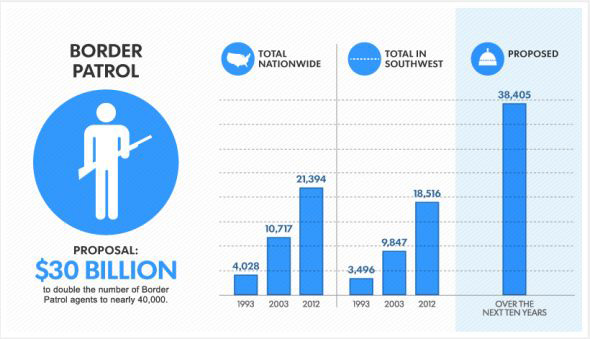
As Bill Maher noted, the addition of that many agents “is going to make the Border Patrol bigger than the FBI — you could put one agent every 250 feet.”
2) Calls For No Less Than 700 Miles Of Fencing
The Senate bill calls for no less than 700 miles of total fencing along the U.S.-Mexico border:
[T]he Secretary will certify that there is in place along the Southern Border no fewer than 700 miles of pedestrian fencing which will include replacement of all currently existing vehicle fencing on non-tribal lands on the Southern Border with pedestrian fencing where possible, and after this has been accomplished may include a second layer of pedestrian fencing in those locations along the Southern Border which the Secretary deems necessary or appropriate.
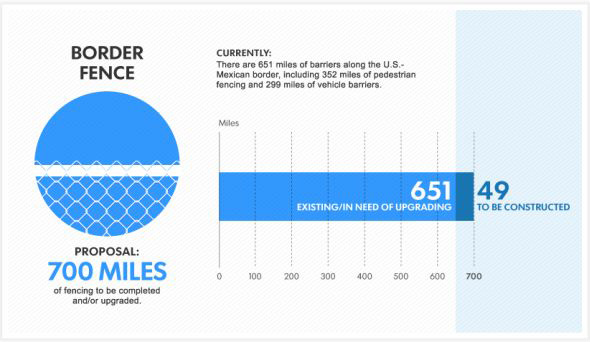
3) Fortifies Border Surveillance
The Senate bill allocates $3.2 billion for additional air and marine support across the Southwestern border, including:
· 4 unmanned aircraft systems
· 6 VADER radar systems
· 17 UH-1N helicopters
· 8 C-206H aircraft upgrades
· 8 AS-350 light enforcement helicopters
· 10 Blackhawk helicopter 10 A-L conversions,
· 5 new Blackhawk M Model
· 30 marine vessels.
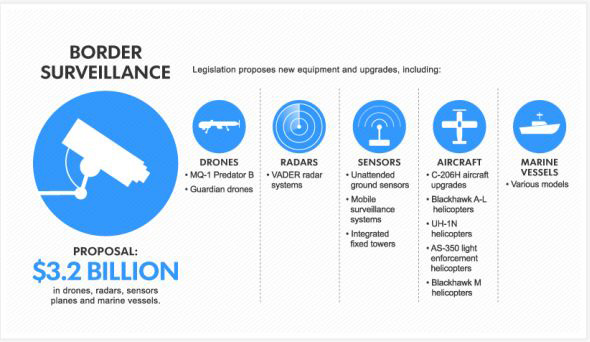
Reminder: Border States Account For More Than Half Of Total U.S. Trade With Mexico
Mexican officials have reportedly criticized the enhanced border measures in the Senate bill. The Washington Post reported on June 27:
[T]he $46 billion in additional security measures offered by the amendment prompted Mexican officials to break their silence this week, when Foreign Minister Jose Antonio Meade told reporters here that “fences don’t unite.”
“Fences are not a solution to the migration phenomenon, and they are not congruent with a safe and modern border,” Meade said. “They don’t contribute to the development of a competitive region that both countries are trying to build.”
Additionally, The Hill reported on July 2 that Rep. Filemon Vela, a Democrat who represents the southernmost tip of Texas, quit the Congressional Hispanic Caucus in protest over the border provisions in the Senate bill. According to the article, Vela stated in a speech on the House floor:
“Erecting more border fence would chill the robust economic relationship that our country and our states enjoy with that country. … Rather than constructing new hurdles to trade with Mexico, we should be tearing down trade barriers in order to promote and strengthen our relationship with our neighbor country.”
Indeed, what is often lost in the debate over border enforcement is the fact that Mexico is the United States’ third-largest trading partner behind Canada and China. Mexico accounted for about 13 percent of total U.S. trade in 2012, totaling about $494 billion. That was up from $461 billion in 2011.
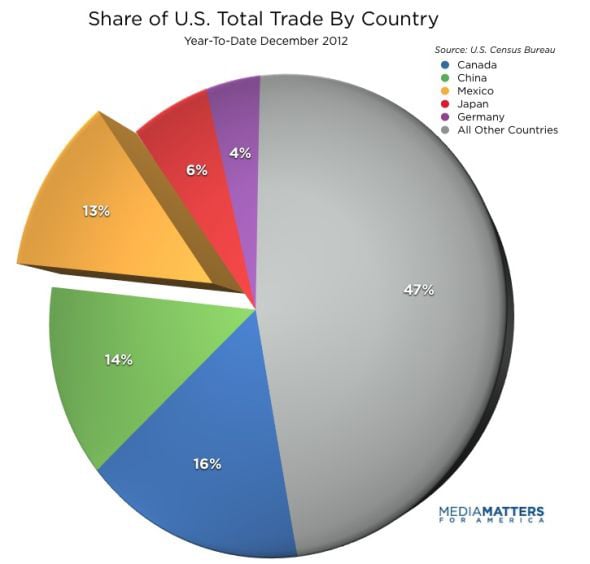
As of April 2013, Mexico’s share of total U.S. trade is 13.3 percent, and remains the U.S.’ third-largest trading partner.
The border states account for a disproportionate share of U.S. trade with Mexico. In all, the four states that border Mexico — Arizona, California, New Mexico, and Texas — generate $271 billion in U.S. trade with Mexico, which is 55 percent of all U.S. trade.
Texas is by far Mexico’s largest state trading partner with $194.4 billion in 2012, which accounts for nearly 40 percent of total trade.

Arizona and Texas count Mexico as their largest import and export partner, with the exception of California and New Mexico. California’s top importers are China and Japan, while New Mexico’s top exporter is Israel and importer is China.
Our most important fundraising appeal of the year
December is the most critical time of year for Truthout, because our nonprofit news is funded almost entirely by individual donations from readers like you. So before you navigate away, we ask that you take just a second to support Truthout with a tax-deductible donation.
This year is a little different. We are up against a far-reaching, wide-scale attack on press freedom coming from the Trump administration. 2025 was a year of frightening censorship, news industry corporate consolidation, and worsening financial conditions for progressive nonprofits across the board.
We can only resist Trump’s agenda by cultivating a strong base of support. The right-wing mediasphere is funded comfortably by billionaire owners and venture capitalist philanthropists. At Truthout, we have you.
We’ve set an ambitious target for our year-end campaign — a goal of $112,000 to keep up our fight against authoritarianism in 2026. Please take a meaningful action in this fight: make a one-time or monthly donation to Truthout before December 31. If you have the means, please dig deep.
